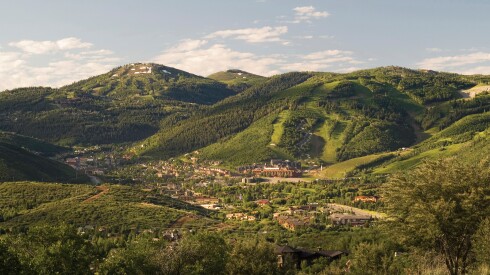“There’s actually a secret ingredient to cha ca,” Hung told me after the server walked away from our table. Hung, a chef and Hanoi native, was introducing me to his city’s classic dish at the restaurant Cha Ca Kinh Ky. “But if I told you, you wouldn’t want to eat it.”
Soon the server returned to deposit on our table a constellation of flavors: a mound of rice noodles, a dollop of shrimp paste, some fish sauce, a couple branches of baby basil, a small bowl of peanuts, and a large bowl of bright green dill and spring onions. Another server brought a frying pan filled with turmeric-laced chunks of ca lang, or Hemibagrus—a genus of catfish—and placed it atop a small portable burner at the center of our table. He mixed in some of the dill and spring onions, and we watched as our meal began to take shape.

Cha ca la Vong originated more than a hundred years ago at the restaurant that gave it its name.
Photo by Justin Mott
If there’s a traveler’s obligation to drink a pint of Guinness in Dublin or eat ragù Bolognese in Bologna, in Hanoi one must eat cha ca La Vong. For a Vietnamese dish, cha ca la Vong is unusual in that it is served exclusively at restaurants—not at the country’s ubiquitous street-side food carts—and cooked at your table. For this latter reason, it is considered a luxury dish. And its sophisticated flavors have led high-profile international chefs—such as Andy Ricker at Pok Pok in Portland and New York, Chris Shepherd of Houston’s Underbelly, and empire-builder Jean-Georges Vongerichten—to plan trips to study cha ca la Vong in Hanoi, just so they can add it to their menus back home. At Cha Ca Kinh Ky, once the fish had cooked, I spooned some into a bowl filled with vermicelli, peanuts, and a sprinkling of fish sauce. The combination was complex, both in flavor and texture, with the turmeric taking center stage on my palate. It was far from the simple Hanoi fare I’d been eating all week, including the national dish, pho. I chewed, studying the flavors. That’s when Hung decided to share the rumored secret ingredient. “Dog fat,” he said.
I stopped chewing.
“But don’t worry, dog fat is hard to find these days. Here they render the fish in either oil or chicken or pork fat.”
I started chewing again.

Ingredients in cha ca la Vong include catfish, basil, peanuts, and rice noodles, among many others.
Photo by Justin Mott
It was good—but Hung was underwhelmed. There was not enough turmeric and not enough sauce to go around. He suggested I try the version at the restaurant that inspired most of those visiting chefs: Cha Ca La Vong, where cha ca originated more than a century ago. There’s a general consensus that the building the restaurant occupies today was, in the late 19th century, a safe house for insurgents fighting French colonial rule. According to the owners, the Doan family, their ancestors fed the dissidents catfish pulled from the nearby Red River mixed with whatever they had on hand, including dill, a main flavor in the dish (and an ingredient that’s rare in the rest of Vietnam). The Doan family still runs the restaurant—and cha ca la Vong is the only dish they serve. To taste it, one must climb steep, ladderlike stairs to the second floor—and pay what, for Vietnam, is a handsome price (about $15 for two people, nearly double the price at other cha ca restaurants).
Once I caught my breath and took a seat, a sauté pan was placed on a charcoal burner at my table. Again, I watched as the server cooked the fish, tossed in a handful of dill, and then deposited everything into my bowl. I took a bite.
Immediately, I understood why this place can charge so much for its cha ca: The turmeric-laced sauce from the fish, rendered with oil, not dog fat, had spread throughout the bowl, coating the noodles and veggies. The soft fish conspired with the snap of raw basil, the crunch of peanuts, and the freshness of the cooked dill and spring onion to create a textural delight. And call me a nontraditionalist, but I didn’t even miss the dog fat.

For a Vietnamese dish, cha ca la Vong is unusual in that it is served exclusively at restaurants and cooked at your table.
Photo by Justin Mott
Where to eat cha ca la Vong in Hanoi Cha Ca La Vong
The original cha ca restaurant. Climb up the steep steps, take a seat, and the ingredients and tableside sauté pan magically appear. 14 Cha Ca, Hoan Kiem, +84 4-3825-3929
Cha Ca Kinh Ky
Chef Nguyen Thi Thuan cooks up a version of cha ca la Vong from a recipe handed down from her grandmother. 104 Hoa Ma, Ngo Thi Nham, Hai Ba Trung, +84 4-3945-4656
Cha Ca Thang Long
Traditional cha ca la Vong served up in a spacious dining room in Hanoi’s old quarter. 19-21-31 Duong Thanh, Cira Dong, Hoan Kiem, +85 4-3824-5115
Cha Ca Thuy Hong
Popular with tourists and locals alike, Thuy Hong is a solid choice for cha ca la Vong. 12 Hang Ga, Hang Bo, Hoan Kiem District, +84 4-3825-7924











